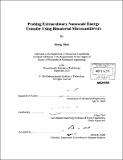Probing extraordinary nanoscale energy transfer using bimaterial microcantilevers
Author(s)
Shen, Sheng, Ph. D. Massachusetts Institute of Technology
DownloadFull printable version (12.67Mb)
Other Contributors
Massachusetts Institute of Technology. Dept. of Mechanical Engineering.
Advisor
Gang Chen.
Terms of use
Metadata
Show full item recordAbstract
Nanostructured materials have recently drawn a great deal of attention in the field of energy research such as for solar photovoltaic, thermophotovoltaic and thermoelectric applications. The energy transport properties of nanostructures can differ greatly from their bulk counterparts because the characteristic dimensions of nanostructures are often comparable with the wavelength or the mean free path of energy carriers such as photons, phonons and electrons. Due to the small dimensions, probing energy transfer at the nanoscale is extremely challenging. By developing new experimental techniques based on the bi-material microcantilevers used in Atomic Force Microscopes (AFM), this thesis has studied several extraordinary energy transfer phenomena at the nanoscale including near-field radiation beyond Planck's law, high thermal conductivity polymers and the optical absorption of micro/nanostructures. First, surface phonon polaritons, which is one type of electromagnetic surface waves, are demonstrated to enhance the thermal radiation between two surfaces at small gaps by measuring radiation heat transfer between a microsphere and a flat surface down to a 30 nm separation. The corresponding heat transfer coefficients at nanoscale gaps are three orders of magnitude larger than that of the Planck's blackbody radiation limit. This work will have practical impacts in areas such as thermophotovoltaic energy conversion, radiative cooling, and magnetic data recording. Next, a new technique is developed to fabricate ultra-drawn polyethylene nanofibers. We demonstrated that these ultradrawn nanofibers can have a thermal conductivity as high as ~ 100 W/m.K, which is about a 3 orders of magnitude enhancement compared to that of bulk polymers. Such high thermal conductivity polymers can potentially provide a cheaper alternative to conventional metal-based heat transfer materials. Finally, an experimental setup is presented to directly measure the spectral absorption of individual micro/nanostructures in applications to solar photovoltaics. Further refinement on experimental technique and characterization using the platform will guide the optimization of dimension, shape, and materials selections of nanostructures in order to maximize the efficiencies of solar cells.
Description
Thesis (Ph. D.)--Massachusetts Institute of Technology, Dept. of Mechanical Engineering, 2010. Cataloged from PDF version of thesis. Includes bibliographical references.
Date issued
2010Department
Massachusetts Institute of Technology. Department of Mechanical EngineeringPublisher
Massachusetts Institute of Technology
Keywords
Mechanical Engineering.